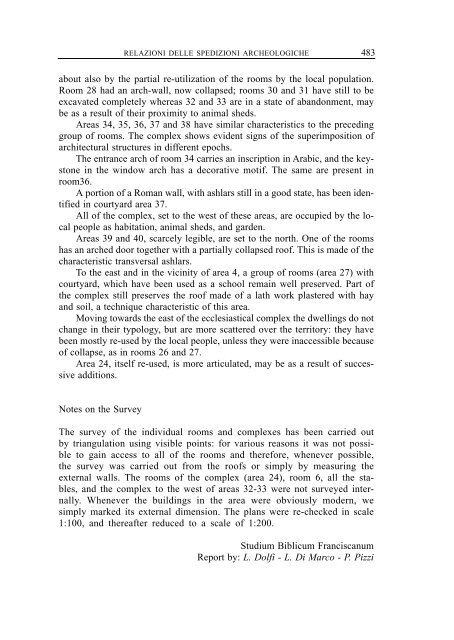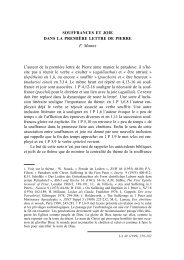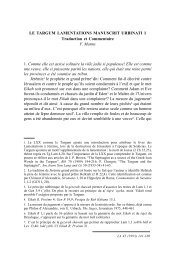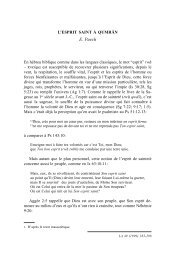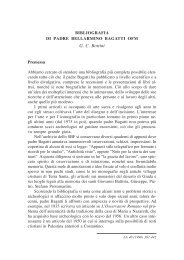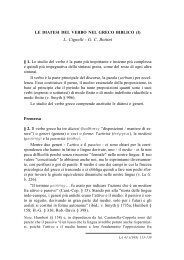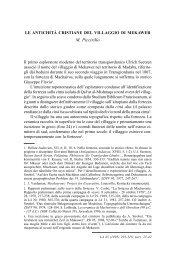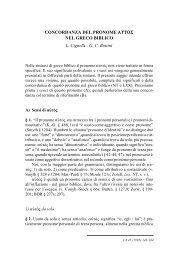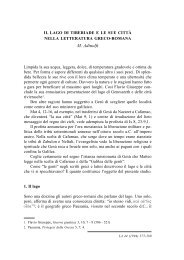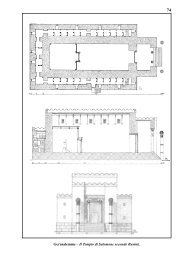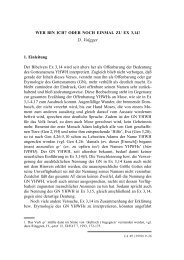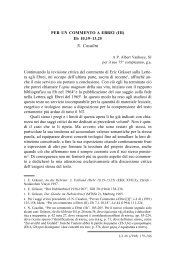Ricerca storico-archeologica in Giordania XVII – 1997
Ricerca storico-archeologica in Giordania XVII – 1997
Ricerca storico-archeologica in Giordania XVII – 1997
You also want an ePaper? Increase the reach of your titles
YUMPU automatically turns print PDFs into web optimized ePapers that Google loves.
RELAZIONI DELLE SPEDIZIONI ARCHEOLOGICHE 483<br />
about also by the partial re-utilization of the rooms by the local population.<br />
Room 28 had an arch-wall, now collapsed; rooms 30 and 31 have still to be<br />
excavated completely whereas 32 and 33 are <strong>in</strong> a state of abandonment, may<br />
be as a result of their proximity to animal sheds.<br />
Areas 34, 35, 36, 37 and 38 have similar characteristics to the preced<strong>in</strong>g<br />
group of rooms. The complex shows evident signs of the superimposition of<br />
architectural structures <strong>in</strong> different epochs.<br />
The entrance arch of room 34 carries an <strong>in</strong>scription <strong>in</strong> Arabic, and the keystone<br />
<strong>in</strong> the w<strong>in</strong>dow arch has a decorative motif. The same are present <strong>in</strong><br />
room36.<br />
A portion of a Roman wall, with ashlars still <strong>in</strong> a good state, has been identified<br />
<strong>in</strong> courtyard area 37.<br />
All of the complex, set to the west of these areas, are occupied by the local<br />
people as habitation, animal sheds, and garden.<br />
Areas 39 and 40, scarcely legible, are set to the north. One of the rooms<br />
has an arched door together with a partially collapsed roof. This is made of the<br />
characteristic transversal ashlars.<br />
To the east and <strong>in</strong> the vic<strong>in</strong>ity of area 4, a group of rooms (area 27) with<br />
courtyard, which have been used as a school rema<strong>in</strong> well preserved. Part of<br />
the complex still preserves the roof made of a lath work plastered with hay<br />
and soil, a technique characteristic of this area.<br />
Mov<strong>in</strong>g towards the east of the ecclesiastical complex the dwell<strong>in</strong>gs do not<br />
change <strong>in</strong> their typology, but are more scattered over the territory: they have<br />
been mostly re-used by the local people, unless they were <strong>in</strong>accessible because<br />
of collapse, as <strong>in</strong> rooms 26 and 27.<br />
Area 24, itself re-used, is more articulated, may be as a result of successive<br />
additions.<br />
Notes on the Survey<br />
The survey of the <strong>in</strong>dividual rooms and complexes has been carried out<br />
by triangulation us<strong>in</strong>g visible po<strong>in</strong>ts: for various reasons it was not possible<br />
to ga<strong>in</strong> access to all of the rooms and therefore, whenever possible,<br />
the survey was carried out from the roofs or simply by measur<strong>in</strong>g the<br />
external walls. The rooms of the complex (area 24), room 6, all the stables,<br />
and the complex to the west of areas 32-33 were not surveyed <strong>in</strong>ternally.<br />
Whenever the build<strong>in</strong>gs <strong>in</strong> the area were obviously modern, we<br />
simply marked its external dimension. The plans were re-checked <strong>in</strong> scale<br />
1:100, and thereafter reduced to a scale of 1:200.<br />
Studium Biblicum Franciscanum<br />
Report by: L. Dolfi - L. Di Marco - P. Pizzi


